How Install A New Main Service Panel
Billow Box Safety: How to Connect a New Circuit
Add a new circuit to your home'southward wiring
Every editorial product is independently selected, though we may be compensated or receive an affiliate commission if you purchase something through our links. Ratings and prices are accurate and items are in stock as of time of publication.
![]() Time
Time
A full day
![]() Complication
Complication
Advanced
![]() Toll
Toll
$51–100
Introduction
Adding a new excursion tin be a daunting and fifty-fifty unsafe task. We evidence you how to practise it with step-by-step instructions and important, life-saving safety tips.
Tools Required
Materials Required
- AFCI circuit breaker
- Cable clamp
- electrical staples
Know What You're Getting Into
We believe in rubber DIY. That'southward why we've always been reluctant to bear witness readers how to open up a breaker box and connect a new circuit. Even with the power close off, in that location's a gamble you could touch the incorrect parts and kill yourself. But then we figured if nosotros didn't show you, you'd just get search it somewhere else. And that scared united states of america fifty-fifty more. So we're going to walk you through the process, showing you the safest way to open the billow box, wire a new breaker, and exam your work.
Opening the main excursion breaker panel box and adding a excursion is actually pretty easy. Y'all just have to connect 3 wires to add a circuit, and each circuit wire is colour-coded. But at that place are some safety precautions, and if you ignore them, you could impale yourself. Really. If you follow our safety steps in order and to the letter, you'll be fine. Just if at any bespeak yous're unsure how to continue or feel uncomfortable with the project, call an electrician.
Stay away from the large wires and lugs. They're ever live, fifty-fifty with the main breaker (service disconnect) shut off. If you touch them, you could die. Cover the live areas with a cardboard shield to foreclose accidental contact while adding a circuit. If yous have whatever doubts most which areas stay live, contact an electrician. There'south a reason awareness of electrical issues is a cardinal footstep in preventing fires in the home.
Watch this video to meet the safe way to connect a new circuit yourself:
Go the Right Parts and Tools
Before you go shopping, open the door of your breaker box and copy the manufacturer'due south name, the box model number, and the style numbers of the breakers that are approved for your box. Then purchase i of those breakers. If your habitation heart doesn't sell the right model or brand, y'all'll have to go to an electrical supplier. You cannot install a circuit billow style that isn't specifically canonical for use in your box — even if it fits inside the box.
While at the store, option up a few 1/2-inch plastic snap-in cable clamps to secure the new cablevision. They're safer than metal clamps considering you don't put your hand in the panel to install them.
If yous need a reminder virtually how bad some amateur electrical can be, bank check out this listing of the virtually mutual electrical code violations.
Y'all have to shut off the power to your whole firm, then yous'll need a powerful work calorie-free. An LED headlamp is also a nifty thought and so you won't have to juggle a flashlight, wire strippers and a screwdriver. Round upwards a utility knife, wire strippers, electric tape, a circuit tester (not a voltage sniffer), and a flat-blade screwdriver or No. 2 square-drive tip for your multi-bit driver. These are the 2 must-take tools for DIY electrical piece of work.
Project pace-by-step (12)
Step 1
An Within Look at Your Chief Breaker Panel
Your master breaker panel might not be exactly like the one here. With any panel, find the large cables and the lugs they're connected to. They're the parts that are always live, fifty-fifty when the main breakers are switched off. Here'south how to know what's what:
- A: Main lugs. They're always live — fifty-fifty when the main breaker is off. NEVER Affect THEM.
- B: Main cables. The black ones are ever live. And although they're insulated, avoid touching them.
- C: Main breaker. Always switch it off before removing the panel'due south comprehend.
- D: Breaker. The hot wire (usually red or black) from each circuit connects to a billow. If yous're installing an AFCI billow (as shown on the post-obit pages), you'll likewise connect the neutral wire to the breaker.
- E: Breaker jitney. Distributes power from the main billow to the individual excursion breakers. Each billow snaps onto the bus.
- F: Neutral omnibus. All ground and neutral (white) wires connect here. If yous're installing a standard breaker, the neutral (white) wire connects here, too. If you're installing an arc-fault circuit interrupter (AFCI) billow, you'll connect the neutral to the breaker and run a "pigtail" wire to the neutral bus.
- Thousand: Breaker space. This console has room for 3 more breakers. You tin install your new breaker in whatever open space.
Plus: Bank check out these 11 existent-life epic electrical fails.

Stride ii
Your Chief Breaker Console Might Look Like This
The photo shows a different configuration where the big cables and lugs are located on the correct-hand side of the circuit breaker box, rather than at the eye.
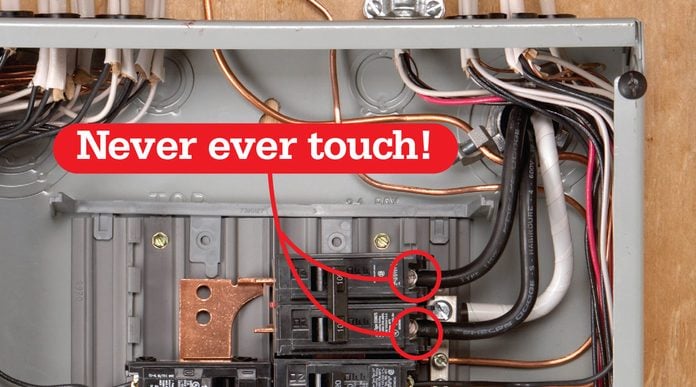
Step 3
Power Down, Then Remove The Cover
- Turn off all computers in the house before y'all switch off the power.
- And then switch off the primary breaker (the service disconnect).
- Remove iii of the panel box cover screws.
- Then concur the cover securely while y'all remove the quaternary screw.
- Pro tip: If it slips while you're removing screws, it tin damage the breaker handles.

Step 4
Exam to Make Sure it'south Dead
- It'southward dangerous to assume the power is really off just because you've flipped the service disconnect to the off position. Be absolutely sure all the ability is off.
- At that place's a slim run a risk that the service disconnect didn't work properly, keeping power to some breakers.
- And then test each and every billow to make sure it's really dead.
- Bear on ane lead of a test light to the neutral bus and the other lead to the screw on each breaker.
- If the test light lights upwardly, cease and call an electrician.
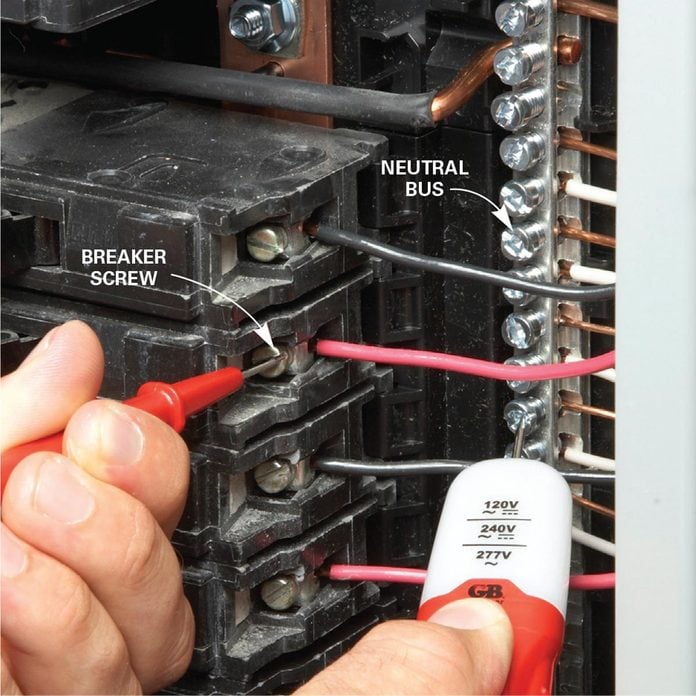
Step 5
Insert a Cardboard Safety Shield
- Yous tin can insert the new cablevision into whatever knockout on the top, lesser, or sides of the panel box.
- Find the to the lowest degree congested expanse and remove one small knockout.
- Jam a needle-nose pliers or a brusk screwdriver into the knockout to bend it down.
- Then grab the "slug" with your pliers and twist it dorsum and along until it breaks off.
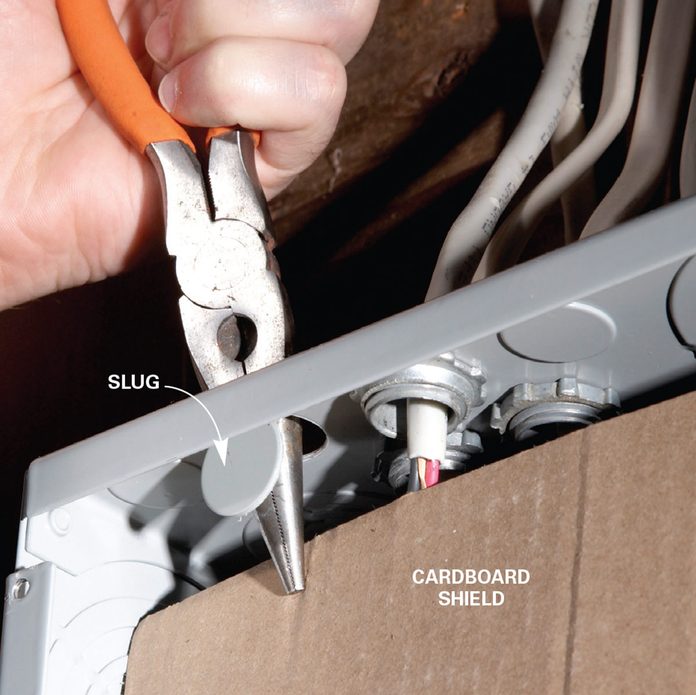
Step vi
Run the Cable Through the Clamp
- Snap in a plastic clamp and then feed in the cable.
- Pro tip: The screw-style ones shown aren't as easy to use.
- Agree the cable upwards to the box to make up one's mind how much of the outer jacket you lot should strip off.
- Piece off the jacket and remove the paper insulator.
- Then wrap the ends of the loose wires with electric tape to prevent them from touching a live portion of the box.
- Pro tip: Tape the wires together so one doesn't stray behind the cardboard.

Step seven
Push Until the Jacket Enters the Clench
- Go along pushing the cable into the clamp far enough to get at least one/4-inch of the outer jacket within the box.
- So secure the cable outside the box with an insulated staple within 12 inches of the clamp.
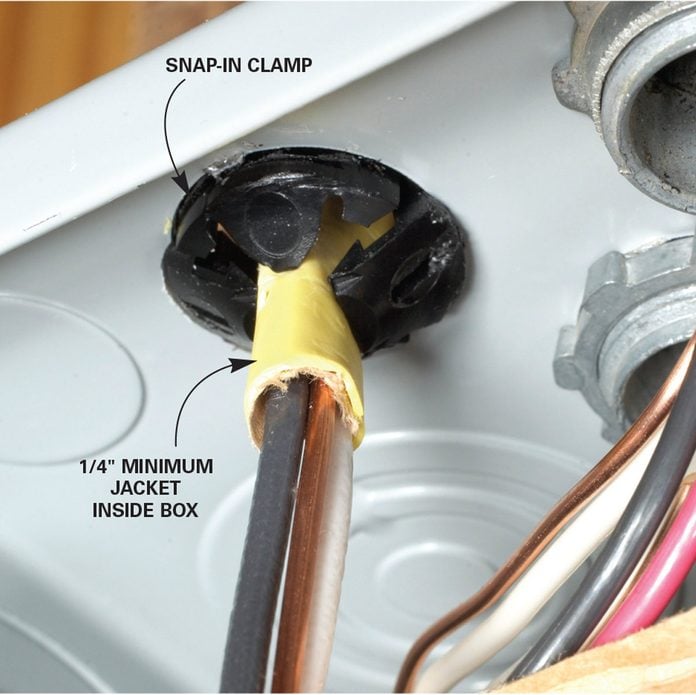
Step 8
Route the Cable and Install the Breaker
- Install the breaker by slipping the tab into the hook.
- Then snap the breaker into identify, forcing the slot onto the passenger vehicle.
- Pro tip: We're using an AFCI billow.
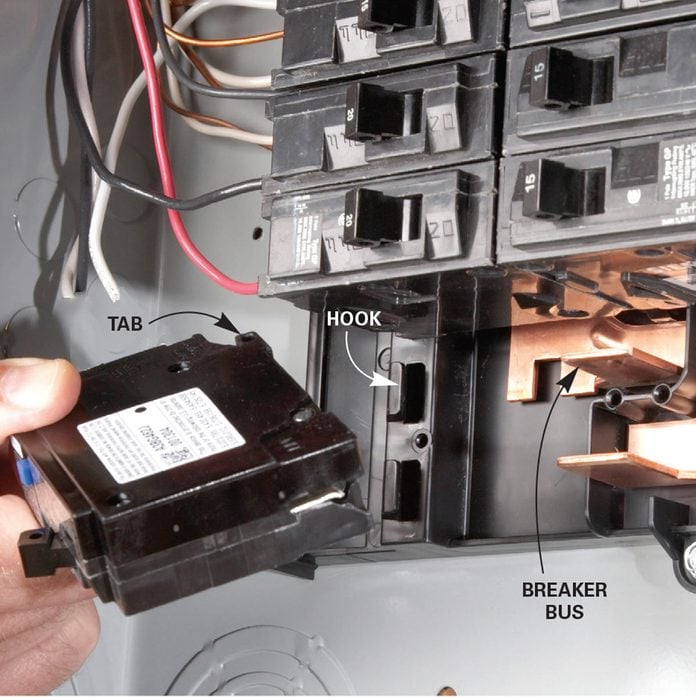
Stride 9
Strip and Clamp
- Neatly road the black and white wires to the empty billow space.
- Attach the wires to the breaker and then snap it into the box, or install the breaker get-go and insert the wires concluding.
- Pro tip: Just be enlightened that wiring an AFCI-style breaker is different from wiring ordinary breakers.
- The neutral (white) from the new cablevision attaches to the AFCI
- Strip off 5/viii-inch of insulation from the white and black wires and insert them into the AFCI terminals.
- Tighten until snug.
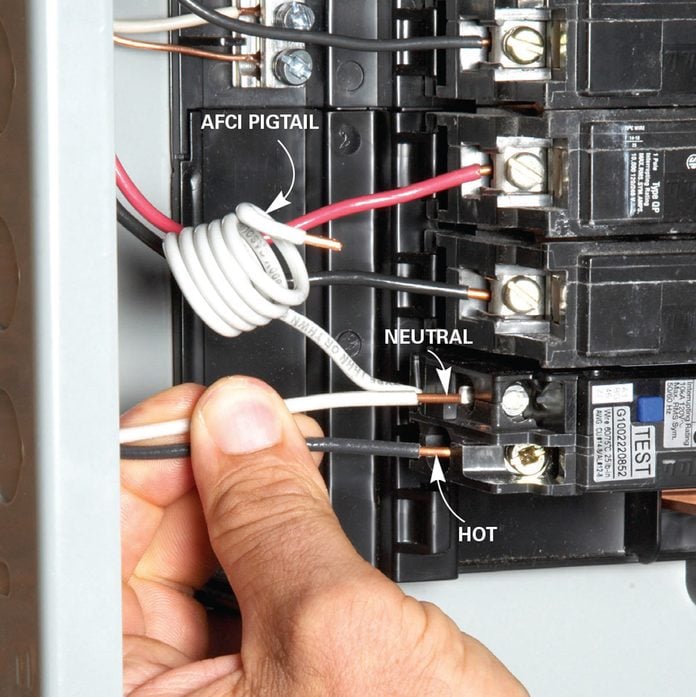
Step 10
Ground and Pigtail go to the Neutral Charabanc
- On a principal panel, you connect the ground wire from the new cablevision and the neutral (white) pigtail from the AFCI to the neutral coach.
- Road the AFCI neutral pigtail and ground wires to empty screws on the neutral bus and tighten.
- If you're installing a breaker on a sub-console, place the neutral and ground on separate bus bars.

Pace 11
Test the Installation and Finish the Job
- Remove the panel box embrace plate knockout that corresponds to the slot where you installed the new breaker (bend it back and forth until it breaks off).
- So install the cover and turn on the main breaker.
- Switch the new AFCI to "ON."
- Wait a few seconds and printing the "TEST" button.
- The billow should trip.
- If it doesn't trip, refer to the package instructions for troubleshooting or call an electrician.

Step 12
How to Plan a New Branch Excursion
- You can ordinarily mix lighting and receptacles on the same circuit. But it's non a practiced thought to identify lighting and receptacles in the same room on a single circuit. If the breaker trips, you lot'll lose all the low-cal fixtures and receptacles at the same fourth dimension.
- If you're wiring living areas, you tin can install 10 to 13 lights and receptacles on a single xv-amp circuit. Locate the receptacles so you're never more than 6 anxiety away from one on each wall.
- Run a separate xv- or twenty-amp circuit for each of these watt-sucking appliances: garbage disposer, dishwasher, microwave, vent hood, trash compactor, and space heater.
- Run a separate twenty-amp circuit to each bath and laundry room. Install a minimum of 2 twenty-amp circuits for the kitchen. Protect the receptacles with a ground-mistake excursion interrupter (GFCI) breaker or GFCI-way receptacles.
- Use 12-gauge cable for 20-amp circuits and 14-approximate for xv-amp. Many cable manufacturers colour-code the outer jacket of their cable, but the color schemes are not universal. And so always double-cheque the wire itself to be sure.
- New branch circuits to all "living areas" (chamber, living room, family room, den, dining room, library, sunroom, cupboard, hallway, and like locations) must be connected to an arc-fault circuit interrupter (AFCI). AFCI breakers are pricey, then you may exist tempted to buy an ordinary $5 billow. Don't. The electrical inspector will but make y'all alter information technology out.
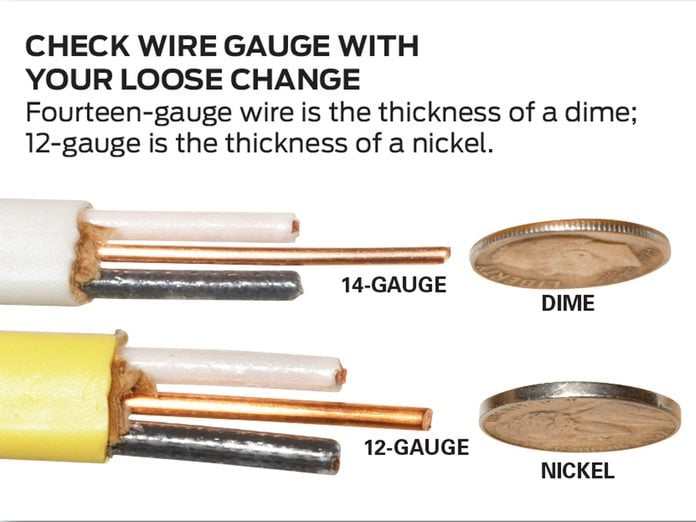
Originally Published: March 31, 2021
How Install A New Main Service Panel,
Source: https://www.familyhandyman.com/project/breaker-box-safety-how-to-connect-a-new-circuit/
Posted by: jaynesdiouse.blogspot.com


0 Response to "How Install A New Main Service Panel"
Post a Comment